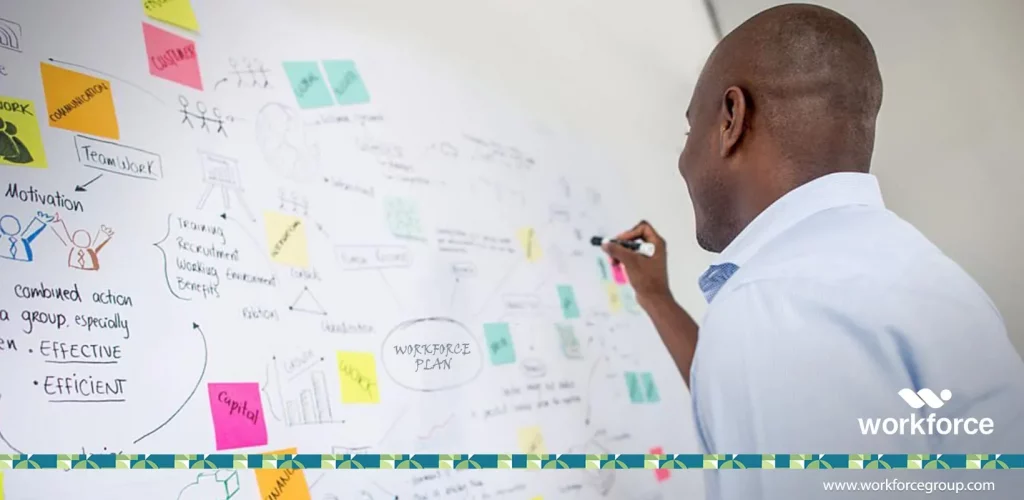Workforce planning can be one of the best practices a company can imbibe to achieve its strategies. This vital practice should not be seen just as a plan with timelines but as a strategic organisational development activity.
As significant as a workforce plan seems, many HR leaders and business executives find it challenging to execute, which points to the fact that many organisations are not sufficiently aware of the present or future workforce gaps that will limit the execution of their business strategy.
According to the Future of HR 2020 survey, three in five HR leaders believe HR’s function will rapidly become irrelevant if it doesn’t modernise its approach to understanding and planning for the future needs of the workforce.
How to Create a Workforce Plan – Step by Step Guide
Workforce planning should be considered a strategic initiative for an organisation. When developing a workforce plan, the following steps should be considered
Understand your Current Business Strategy and Analyse your Talent Supply
The best way to start is to look inwards and analyse your current situation. As a manager, you should carry out both internal and external talent assessment. You might ask questions such as:
- “Does my team consist of long-tenured talent that might retire soon and leave the organisation with significant gaps?”
- “What are the strengths of my current team, and how do they map to our current needs?
- ”How available is the talent that I need in the present market?”
- “What is the cost of getting new talent?”
Assessment of your organisation’s talents does not only save time and money but is critical to your organisation’s success.
According to the talent management insights group study, when leadership is not assessed correctly, the organisation suffers.
Performance on key objectives decline on average by 34 per cent, senior leadership roles are occupied by external candidates who are more expensive and slower to onboard, and the organisation is 21 per cent more likely to fail.
Consider your Future Needs
Next, you need to complete a review of your future business plans and objectives. Get information around what your team have to accomplish, projected workload differences and staffing levels. What are the skills that are critical to achieving these objectives?
Recommended Post: COVID-19: Business Implications and Insight
Identify the Gaps (Gap Analysis)
Now, what are your needs? Compare the differences between your supply and demand assessments.
Identify the skill surpluses and gaps that are linked to the strategic work you must accomplish.
For example, do you need to fill a specific role, or do you need different skill sets that people in your workforce already have given the new strategies your business has to carry out?
Find the Solution
You can then address the gaps in your current and future staffing needs by designing a cost-effective workforce model.
As a business leader, you should assess opportunities to develop your current employees, and consider hiring externally to complement your current teams’ skills. If you recruit outside the organisation, where would you go, and how many new hires do you need?
Once you’ve solved for the necessary gaps, you’ll need to manage the integration of the new talent into your current team.
When a group has prepared and equipped their internal talent for a future need, they are better prepared to ramp up rapidly on new projects.
Though not as easy as it looks but if carefully thought out and executed, significant benefits of implementing strategic workforce planning include:
- Facilitating the prioritisation
- Development and funding of workforce initiatives (for example, education and training); Improvement of employee engagement
- Retaining talent
- Increasing efficiency
- Identifying gaps
- Enhancing employee onboarding
- Minimising risk
It also includes informing decisions on better structuring an organisation to deploy their workforce to overcome identified internal or external barriers to accomplishing strategic workforce goals and long-term success.
With the right team and tools in place, you can adequately plan for the future and ensure your organisation meets its strategic goals.
Must Read: Business Acumen – A Must-Have Skill for All HR Professionals
Key Issues to Avoid When Creating a Workforce Plan
Before you get right into your planning efforts, it’s helpful to understand the loopholes that organisations commonly accommodate or overlook in their planning process. These are some of the issues to avoid when creating a workforce plan.
Focusing on Only the Short-term Initiatives
One mistake business people make is to create a plan for the short-term. For example, currently, a company might create a workforce plan for only six months when they are likely to have “overcome” the effects of the COVID-19 pandemic. This thought process breeds a negative impact because as long as an organisation exists, there should always be a plan for its workforce. The workforce itself is arguably the most important tangible asset of most organisations and has to be carefully planned, measured or optimised at all times. If you cannot plan for the long term probably to avoid the risk of poor forecasting, plan for the shortest period possible, iterate your plan continuously, make adjustments and adapt.
Minimal (or no) Support from Leadership
Should the responsibility of creating and implementing the workforce plan be left to only the HR leads?
The answer is NO. Strategic workforce planning has the most significant impact when it is a business process owned by the business. During tight economic times, only CFOs and senior business managers have any real authority.
Hence, this should not be seen as a process that benefits just the HR unit but for the business as a whole.
If made a collaborative effort, human resources will be able to make better high-level decisions about recruitment, development, redeployment, and transition programs; senior leadership will be able to monitor the people health of the organisation and the organisational capacity to meet present and future business objectives.
Failure to Communicate Plans Internally
The business executives and HR department should not be the only ones aware that a workforce plan is either being created or executed.
Employees within the organisation must be involved or aware so that this is internalised and they are better aware of the organisation’s strategy and their contribution to it.
For example, workforce planning in “the new normal” might require that employees take new or additional roles within an organisation. Lack of awareness of the reason for the shift to a new role does not help internalisation.
Instead, employees feel forced, and this leads to demotivation and reduced productivity. This would make workforce planning and execution efforts futile.
Making Decisions with Inaccurate Employee Data
Inaccurate employee data informs wrong decision making during the workforce planning process.
If you don’t have correct data on your current workforce, you are likely to either hire a new person for a role that an existing employee possesses thereby incurring unnecessary expenses.
For example, your customer service representative could have database management skills, but you’re not aware because you do not have his updated information.
Avoid overkills because this reduces productivity. Organisations should put in place a system for regular employee data capture that details up-to-date skills and capabilities.
Lack of Tools and Resources for Execution
Not all companies have the capabilities to create an accurate plan or carry one out, even if the plan is a solid one.
However, organisations still force their way into this important part of their strategy, usually because of cost only to fail and end up expending more cost. This often leads to poor execution.
Consider leveraging partnerships with organisations that can help to fill the gaps in technology and resources required when creating and executing your plan. A trusted outsourcing service provider can fill this gap accurately and has proven to be cost-effective.
Conclusion
Workforce planning is where strategy is brought to life so vividly that we can construct a workforce around it.
Whether you’ve been tasked with workforce planning or you’re proactively looking for ways to improve workforce planning at your organisation, you may find yourself wondering how employers can overcome these obstacles and effectively plan for the future.
An organisation’s employees are, without a doubt, its most substantial assets; therefore, it goes without saying that workforce planning is critical for long-term success.
The right outsourcing partner can help you effectively overcome many of the common obstacles that come with planning for the future or “the new normal”, and restructuring as your organisation grows and evolves.
At Workforce Group, We have contributed to making execution successful for over 60 clients through our expertise and upbeat technology.
Schedule your free consultation to find out how we can contribute to making sure that you have a successful workforce planning execution.



